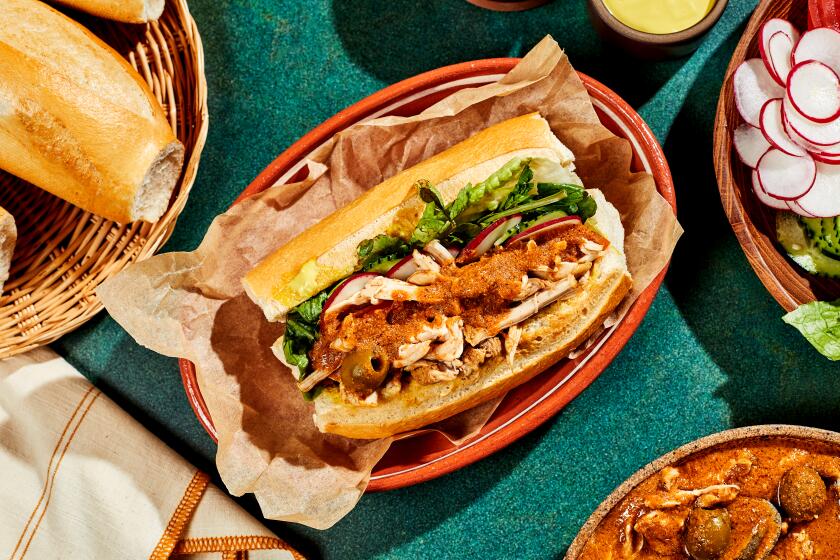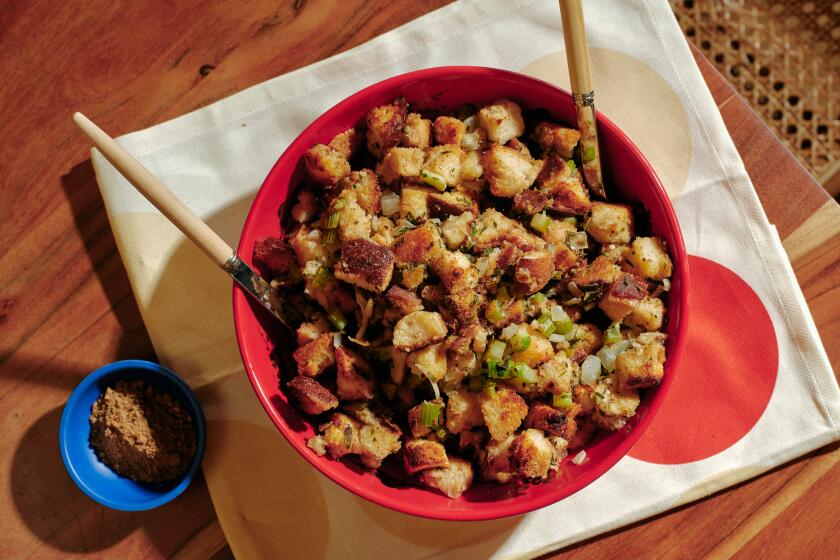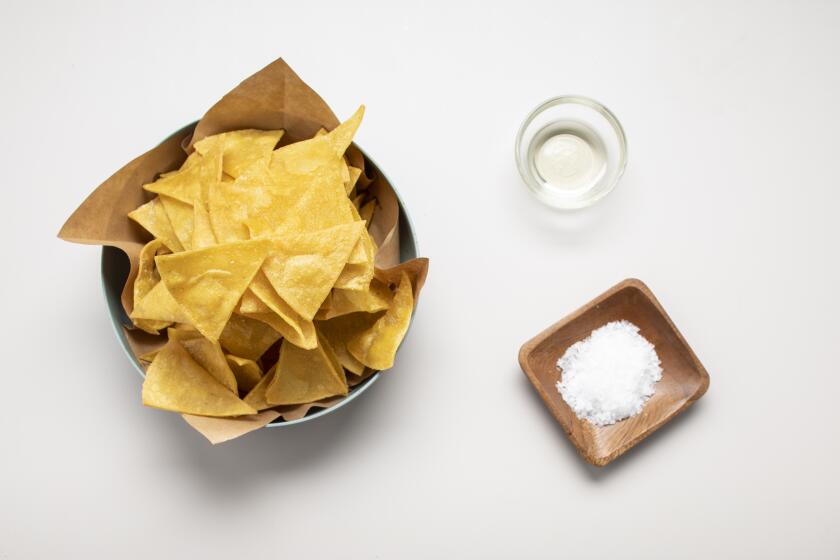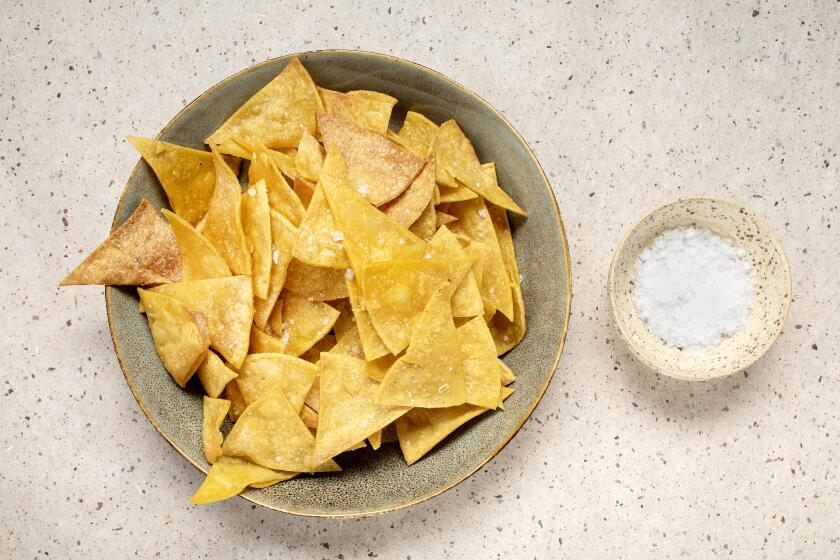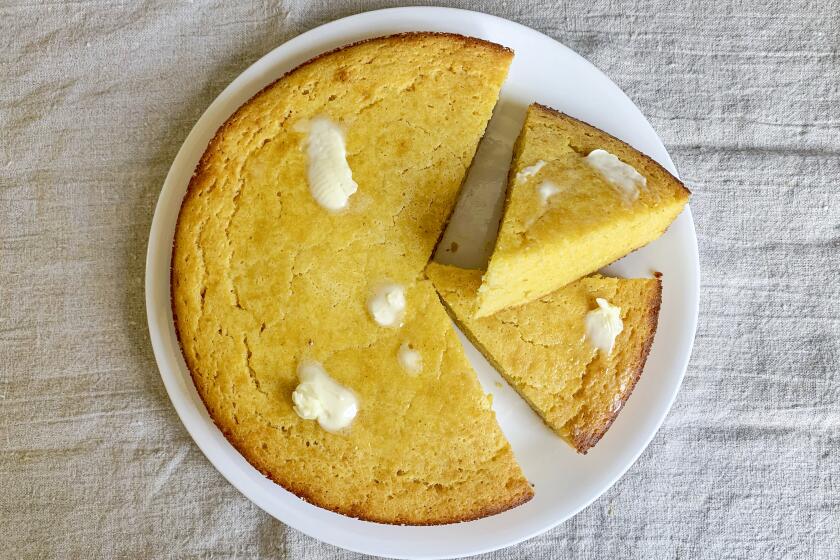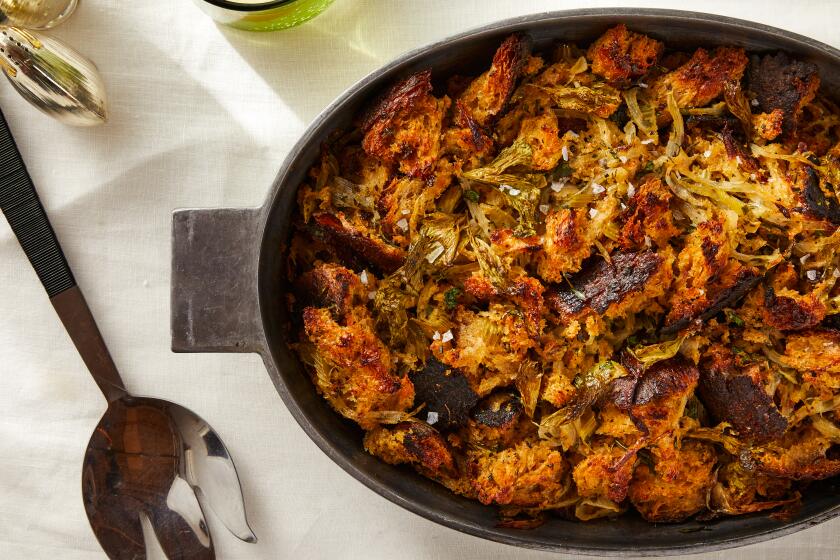Pan de muerto
A mug of warm champurrado, a soul-satisfying chocolate drink thickened with masa. Tamales like cornhusk offerings, wrapped gifts for the hungry guests. Sugar-dusted loaves of pan de muerto, the bread decorated with “bones” formed of dough. A plate of turkey smothered in a spicy black mole, as dense and dark and mysterious as the coming night.
On the altars and dinner tables, Dia de los Muertos, or Day of the Dead, is about celebrating the spirits of the dead, not running from them. Unlike Halloween, these ghosts don’t haunt so much as visit, returning to a daylight world of incense and bread, chocolate and marigolds.
For Sandi Romero -- known to friends, family and tamale lovers everywhere as “Mama,” of Mama’s Hot Tamales Cafe near MacArthur Park -- Dia de los Muertos is a deeply personal celebration. Personal, but not private: Romero has been hosting parties celebrating the holiday at her home for decades.
In the five years since Mama’s Hot Tamales Cafe opened in 2003, that party has widened to include not only Romero’s family, but also the chefs and tamale vendors who come through the cafe -- which is a restaurant-business training center for the Institute for Urban Research and Development -- as well as local customers and tamale lovers who make the pilgrimage to Mama’s from as far away as Australia.
This year, Romero is also cosponsoring the fourth annual Los Angeles International Tamale Festival and Dia de los Muertos, a three-day fair held this weekend in the blocked-off street running the length of MacArthur Park -- right in front of the bright, blue awnings of her popular cafe.
Romero’s annual party just got a whole lot bigger.
Feasting on the traditional foods of the holiday (tamales, turkey in mole, pan de muerto and champurrado are some of the most popular) isn’t the primary focus of the day, but a secondary event, something that happens once the altars are built, the spirits remembered.
“You serve them first,” says Romero of the spirits and of the food traditionally placed at the altars and in cemeteries to honor the souls of the dead. “You remember them and then you eat.”
But eat you do, especially if you come to Mama’s heavily laden table.
Longtime tradition
Romero, a third-generation Angeleno, grew up with six siblings in the San Fernando Valley before she married and had a daughter and moved to Pasadena. Her grandfather was from Puebla, Mexico, her grandmother from Durango.
“Growing up, that was my thing: I loved Dia de los Muertos.” Romero, a former Aztec dancer, remembers dancing in the cemeteries on the holiday and hosting parties at her house celebrating the event.
After a number of deaths in her family, the holiday became even more important to Romero. The altars she made and decorated with candles and sugar skulls, favorite foods and mementos, became more elaborate, the food made with the tastes of departed loved ones in mind: a bottle of one relative’s favorite beer, atole (a flour-thickened drink similar to champurrado) offered in another’s special ceramic mug.
“We do an altar here every year,” says Romero, surveying the colorful environment at Mama’s, where local artists sell paintings, jewelry and crafts in a dining room that also serves as Romero’s office. And every year, Romero cooks a feast, with some of the food designated for the altar, some for the table.
“This is my gift, the food,” says Romero, who now has two grandchildren.
In addition to tamales, a Dia de los Muertos feast might center on a platter of turkey mole. In Mama’s tiny kitchen, chef Omar Lezcas, from San Pedro Pochutla, Oaxaca, who has been with Romero since the restaurant opened, makes his mole in a big metal pot worn and dented from constant use (at home Lezcas uses a cazuela, the traditional earthenware cooking pot). There’s a giant tamale steamer next to the stove, and the heat in the cramped space is as palpable a force as the pungent scent of roasting chiles.
Lezcas’ mole is dense, with a complexity that’s so subtle it seems almost secretive. The many ingredients -- toasted chiles and chocolate, nuts and raisins and spices, bread and plantains and tomatoes -- are toasted, fried and blended, then cooked down to a paste before being thinned with turkey stock into a smooth sauce with the glossy texture of melted chocolate.
You may feel a bit like a sorcerer, stirring a bubbling vat of black potion, but the results are worth every minute. If you make a large batch (as this recipe calls for), the extra freezes up nicely. And if you have leftover turkey in mole, do what Lezcas does and make tamales.
Flavors of fall
Coming midway through the fall, Dia de los Muertos is also a seasonal celebration. Romero says she’s always made calabacitas (squash), a homey dish of stewed zucchini, corn and tomatoes -- all part of the ongoing fall harvest around here -- for the holiday. It’s a family dish, so making it also became a way of honoring the women who had made it before her.
While you make the pan de muerto, letting the orange-scented dough rise in a warm window, stir together a big batch of champurrado, a rich, creamy drink enriched with Mexican chocolate (tablets of bitter chocolate blended with sugar and cinnamon) and spiked with more cinnamon. Depending on your tastes -- and those of your relatives, both living and departed -- you might add more chocolate to this recipe, sweeten it with additional sugar, or lace the drink with a bit of vanilla. The consistency of champurrado also varies: Some people prefer it thinner, like hot chocolate, while others prefer theirs as thick as porridge. If you like yours thicker, just add more masa.
After the bread dough has risen, form part of it into two large round loaves, then roll out smaller pieces into “bones.” The bones are laid across the top of the rounds, a “skull” in the center is made from a ball of dough, pressed down with flour-tipped fingers to form a ghoulish face.
This is a rich egg bread similar to brioche and flavored with orange zest and orange flower water. Bake it until it’s golden brown, then brush it with melted butter and sprinkle it generously with sugar. You can take half the dough and, instead of making a second loaf, form it into figurines and animals; maybe dust the top with sugar colored a festive pink or purple.
Place some of the bread on the altar, more on the table. Dip a fragrant, buttery slice into a cup of champurrado. Light the candles. Pass around the plates. Turn up the music. After the spirits are honored, the dead remembered, fed and pacified, “then we just party and have fun,” Romero says. “Because we’re here; we’re alive.”
The starter
In the large bowl of a mixer with a dough hook (you can also do this by hand), stir together the flour, salt, sugar and yeast, then gradually beat in one-half cup plus 2 tablespoons water and the eggs. Beat the dough for about 5 minutes, until it forms a loose, elastic mass around the dough hook.
Turn the dough out onto a floured board and form a ball. Place the dough in a buttered bowl and loosely cover with plastic wrap. Set aside in a warm place until the dough doubles, about 2 hours.
Final dough
Put the starter, 1 cup of sugar and the three-fourths cup plus 2 tablespoons softened butter into a large mixing bowl and mix, by hand or with a stand mixer, until well-incorporated. Gradually beat in the flour and the egg yolks with water, alternating a little of each until the flour and yolks are completely incorporated. Beat in one-quarter cup water, the orange flower water and zest until combined. Mix the dough for a few minutes until it is a shiny and sticky mass that just holds its shape. Turn out the dough onto a lightly floured surface and form into a round.
Wash, butter and flour the bowl, and return the dough to it. Cover with plastic wrap and set aside in a warm place for about 1 1/2 hours, until doubled.
Butter 4 baking sheets. Turn the dough out onto a floured board and divide it into two equal portions. Set aside one portion, loosely covered with plastic wrap so it does not form a skin.
Remove one-fourth from the remaining portion of dough and set it aside. Roll the larger portion into a smooth ball, then press it into a circle about 8 inches in diameter and 1 inch thick. Gently flatten the outside edge of the circle to form a narrow rim about one-fourth-inch thick, then transfer the round to one of the greased baking sheets.
Divide the smaller portion into 4 equal parts. Roll one into a ball and place on another greased baking sheet. Roll the three remaining pieces into strips about 8 inches long, each with a few crimps to form “bones.” Add these to the smaller ball on the baking sheet.
Repeat with the remaining portion of dough, forming a larger, rimmed round and dividing the smaller portion into one ball and three “bones.” Loosely cover each baking sheet with plastic wrap and place in a warm place for one hour to rise.
Heat the oven to 375 degrees. Unwrap the first portion of dough (large and small round and three bones) and arrange the “bones” in a spoke-like pattern over the large round. Place the smaller round -- the “skull” -- in the center of the spokes and poke two holes in the center for “eyes.” Repeat with the remaining portion of dough to form a second decorated round. Brush the decorated rounds with the beaten eggs.
Bake the rounds until the loaves are well-browned and springy, about 25 to 30 minutes. Turn off the oven, open the door and allow the bread to sit for 5 minutes. Remove from the oven, brush with the melted butter and sprinkle generously with the remaining sugar. Cool completely, then serve.
Get our Cooking newsletter.
Your roundup of inspiring recipes and kitchen tricks.
You may occasionally receive promotional content from the Los Angeles Times.











